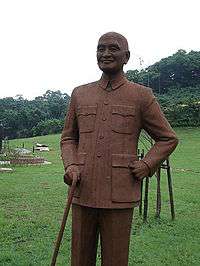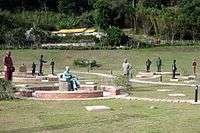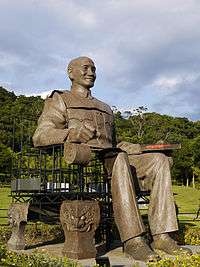Chiang Kai-shek statues

Chiang Kai-shek statues (Chinese: 蔣公銅像; pinyin: Jiǎng Gōng Tóngxiàng; literally: "President Chiang Bronze Statue") are statues of the late Republic of China (ROC) President Chiang Kai-shek. They are found almost everywhere in Taiwan, from parks to schools to military bases, and are usually made of a bronze alloy, although it varies from location to location.[1][2] Some statues have been removed starting in 1999,[3] with greater publicity surrounding removals starting in 2007 under pro-Taiwan independence Democratic Progressive Party (DPP)-led government initiatives, which in turn led to protests and opposition on the grounds of culture and history.
History
President Chiang Kai-shek led the Republic of China and the Kuomintang (KMT) in the Mainland. After the end of World War II, during the subsequent resumption of the Chinese Civil War he lost Mainland China to the Chinese Communists. He retreated to Taiwan with the ROC government and vowed to one day re-take the Mainland (At that time, the ROC had occupied Taiwan before the post-war treaties were in effect, becoming the government in exile.[4] During the following years of rule, the KMT-led ROC government erected monuments commemorating Nationalist leaders, including statues of Chiang Kai-shek.[2]
Statue removal

In 2000, it was estimated there were nearly 43,000 Chiang statues in various locations throughout Taiwan.[3] Daxi District, home to the mausoleums of Chiang Kai-shek and his son, Chiang Ching-kuo, has accepted approximately 200 removed Chiang Kai-shek statues, beginning in 2000 as per the then-current mayor (Tzeng Rung-chien)'s policy.[3][5] The statues were later displayed at the Cihu Memorial Sculpture Garden (慈湖紀念雕塑公園), located at 24°50′29″N 121°17′38″E / 24.8415°N 121.2940°E adjacent to the Cihu Mausoleum. It is also known among expat residents as the 'Garden of the Generalissimos'.[6] The garden is especially popular with visitors from the People's Republic of China.[7][8]
Although the removal of Chiang statues received a great deal of attention, the actual number of statues moved to and subsequently displayed in Cihu is relatively low (approximately 150)[5] compared to the estimated 43,000 statues erected.[3] Other sources state that thousands of statues have been removed.[9] The high-profile statues that have been removed, such as the Kaohsiung seated bronze Chiang statue, have garnered extensive press coverage. However, there are still many Chiang statues remaining in Taiwan, where they continue to watch over public squares, schools, and parks.
2006–08 events
The Ministry of National Defense first proposed removing Chiang statues from military bases in March 2006 as part of a broader nationwide effort to de-politicize the military,[10] although the ostensible reason given was to protect them from erosion and damage.[11] In February 2007, the Republic of China government, under the Taiwan independence-minded DPP Chen Shui-bian administration, began to implement the plan to remove the Chiang statues from military premises.[12] The ruling Democratic Progressive Party claimed that the statues symbolized Chiang Kai-shek's authoritarian rule and cult of personality and were not consistent with the principles of a representative democracy. The opposition KMT, on the other hand, resisted the removal of the statues, claiming that the DPP was attempting to cut off Taiwan's Chinese heritage, and distort history.[13]
On March 9, 2007, the KMT revoked Defense Minister Lee Jye's party membership for removing the statues as ordered by the government. The party stated Lee's actions damaged the party's image. In response, Lee said he regretted the party's expulsion decision, but that he had no plans to join the DPP.[14][15]
In the midst of these events, during March 2007, the large seated bronze statue of Chiang in the city of Kaohsiung's Chiang Kai-shek Cultural Center was removed.
Wounds and Regeneration

The March 12, 2007 removal of the seated bronze statue in Kaohsiung led to clashes between protestors who were against the removal, and police, who were sent to secure the site while city workers dismantled the statue.[16][17] The statue was scheduled to be delivered to Cihu, Daxi Township in Taoyuan County (now Daxi District, Taoyuan City). Before the delivery, on March 15, 2007, the mayor of Daxi, Su Wen-sheng, left for Xikou, Zhejiang, in the People's Republic of China, to ask the mayor of Xikou if he would accept the statue. The deputy director of the Taiwan Affairs Office of Zhejiang Province, Shao Jiangwei, stated the offer was being considered favorably.[18] However, when the statue arrived at Daxi in 79 segmented pieces[19] (originally and erroneously reported as more than 200 pieces),[20] the plan to transfer the statue to Xikou was abandoned.
Instead, the 8m statue was partially reassembled at Cihu by a local artist, Guo Shao-zong, with some missing pieces and unveiled on March 15, 2008.[21] The resulting deconstructionist sculpture, now entitled Wounds and Regeneration[22] is one of the most popular statues in the park.[21]
Chiang Kai-shek Memorial Hall
Discussions to remove or relocate the 10m seated Chiang at the Chiang Kai-shek Memorial Hall started in 2007,[12] followed by the renaming of the memorial hall in March 2007.[23] In response, the Taipei City Government classified the memorial hall (including the statue) as a temporary historical site, which prevented any alteration or damage,[24] and the KMT held a protest to oppose the proposed changes.[25] Prompted by the removal of Chiang statues at other sites, some groups agitated for removal of the Chiang statue in July 2007 to coincide with other changes at the memorial hall.[26]
.jpg)
The renaming of the memorial hall proceeded, but the statue was not removed or covered up, as had been speculated, when the newly named National Taiwan Democracy Memorial Hall re-opened in January 2008. Instead, the statue and its surroundings were decorated with many kites to reflect the theme of "a democratic wind."[27] The kites were removed later that year,[28] but other democracy-related decorations remained, prompting a statement of regret from Chiang's grandson John Chiang. In August 2008, the Executive Yuan withdrew proposed statutes to make the name change permanent,[29] and the memorial hall reverted to its original name, likely ending any threat to remove the Chiang statue inside.
2011 and later events
Since 2008, at least two more Chiang statues have been removed from university campuses. A Chiang statue was moved from the front gate of National Taiwan Normal University in 2011,[30] following debate over the statue's fate dating as far back as 1987,[9][30][31] and another Chiang statue was moved from the campus at National Cheng Kung University in 2013.[32] In 2014, a student-led campaign was launched advocating the removal of all Chiang statues from high school campuses.[33] Shortly after entering office in November 2014, mayor Twu Shiing-jer ordered the removal of Chiang statues within Chiayi.[34]
In March 2015, Tainan removed Chiang statues from fourteen elementary and junior high school campuses and sent them to Daxi at Mayor William Lai's (DPP) direction.[35] Lai announced the plan to remove the statues on 28 February 2015, during an event marking the 68th anniversary of the February 28 Incident, stating the removal was both to avoid the annual vandalism of Chiang statues[36] and to lift the symbols of autocratic rule in Taiwan.[37] KMT Tainan city councilors criticized the secretive manner in which the Chiang statues were removed, and compared Lai to ISIS for wholesale destruction of cultural artifacts.[38] The next day, the mayors of Taipei (Ko Wen-je) and Keelung (Lin Yu-chang) demurred on removing their cities' Chiang statues, seeking to avoid confrontation, while the mayor of Taoyuan City (Cheng Wen-tsan) stated the Chiang statues on Taoyuan's school campuses and public offices would be sent to Daxi.[39] Keelung reversed its position a week later, declaring that its Chiang statues would be removed in the near future.[40] Pro-independence activists threatened to file a lawsuit to remove Chiang statues from Taipei in a statement released in October 2015.[34]
Late in March 2015, DPP legislator Pasuya Yao proposed a nationwide removal of Chiang statues, and further proposed that new currency should be issued to eliminate images of Chiang from the NT$1, 5 and 10 coins and the NT$200 bill.[41]
Gallery
See also
- National Chiang Kai-shek Memorial Hall
- Chiang Kai-shek
- Chiang Kai-shek Memorial Song
- Sun Yat-sen
- List of statues of Lenin
- List of statues of Stalin
References
- ↑ Taylor, Jeremy E. (2006). "The Production of the Chiang Kai-shek Personality Cult, 1929–1975". The China Quarterly. 185: 96–110. doi:10.1017/S0305741006000063. Retrieved November 20, 2014.
- 1 2 Taylor, Jeremy E. (March 2009). "Discovering a Nationalist heritage in present-day Taiwan". China Heritage Quarterly (17). ISSN 1833-8461. Retrieved November 20, 2014.
It displays a large range of disused bronze and stone statues of Chiang (and other Nationalist leaders) that have been donated by institutions throughout the island, and re-arranged with the help of local artists.
- 1 2 3 4 Taylor, Chris (March 26, 2000). "General retreat". Taipei Times. Retrieved November 20, 2014.
- ↑ Huang, Annie (March 17, 2007). "Chiang Kai-shek's legacy attracts respectful Chinese tourists to Taiwanese park". Taiwan News. Associated Press. Retrieved March 17, 2007.
- 1 2 Leavey, Helen (March 11, 2003). "Taiwan divided over Chiang's memory". BBC News. Retrieved November 20, 2014.
- ↑ Sui, Cindy (October 29, 2009). "Intrigue at the Generalissimo's pied-a-terre". Taipei Times. p. 4. Retrieved November 20, 2014.
- ↑ "Feature: Tashi's CKS statues lure Chinese pilgrims". Taipei Times. AP. March 17, 2007. Retrieved November 20, 2014.
- ↑ "Chiang Kai-shek's historical stock rises in China, falls in Taiwan". Want China Times. Taipei. February 13, 2012. Retrieved 20 November 2014.
- 1 2 Emerson, Tony (August 1, 1999). "Escaping the Past". Newsweek. Retrieved November 20, 2014.
- ↑ Chang, Rich (March 21, 2006). "CKS statue proposal generates uproar". Taipei Times. Retrieved November 20, 2014.
- ↑ "Chiang Kai-shek's statues to be removed from Taiwanese military bases". Sina English. March 20, 2006. Retrieved November 20, 2014.
- 1 2 Wang, Flora; Chang, Rich; Shih, Hsiu-chuan (February 6, 2007). "CKS statues' removal nears completion". Taipei Times. Retrieved November 20, 2014.
- ↑ "Taiwan statue removal fuels spat". BBC News. February 6, 2007. Retrieved March 11, 2007.
- ↑ Chuang, Jimmy; Mo, Yan-chih (March 10, 2007). "KMT expels Lee Jye for obeying DPP". Taipei Times. AFP. Retrieved March 16, 2007.
- ↑ "Taiwanese party expels minister". BBC News. March 10, 2007. Retrieved March 11, 2007.
- ↑ Wang, Flora (March 15, 2007). "KMT, DPP at odds over Kaohsiung's CKS center". Taipei Times. Retrieved March 16, 2007.
- ↑ Gluck, Caroline (March 14, 2007). "Taiwan furore over statue removal". BBC News. Retrieved March 14, 2007.
- ↑ "Xikou likely to accept Chiang Kai-shek's statue". The China Post. March 15, 2007. Retrieved March 16, 2007.
- ↑ Wang, Flora (March 19, 2007). "Sculptor not bothered by statue move". Taipei Times. Retrieved November 20, 2014.
- ↑ "Statue of Chiang Kai-shek cut into hundreds of pieces". The China Post. March 16, 2007. Retrieved November 20, 2014.
- 1 2 An, Lin (October 31, 2009). "Sculpture park keeps memory of Chiang Kai-shek alive". Taiwan Today News. CNA. Retrieved November 20, 2014.
- ↑ Wu, Amber (July 25, 2008). "Statue park preserves generalissimo's legacy". Taiwan Today. Retrieved November 20, 2014.
- ↑ Hirsch, Max (March 3, 2007). "CKS Memorial Hall the latest to be rechristened". Taipei Times. Retrieved November 21, 2014.
- ↑ Shih, Hsiu-chuan; Wang, Flora (May 21, 2007). "KMT to sue minister of education for negligence". Taipei Times. Retrieved November 21, 2014.
- ↑ Mo, Yan-chih (March 29, 2007). "KMT says it will protect CKS Hall". Taipei Times. Retrieved November 21, 2014.
- ↑ Loa, Iok-sin (July 16, 2007). "Groups seek removal of CKS giant". Taipei Times. Retrieved November 21, 2014.
- ↑ Ko, Shu-ling (January 2, 2008). "National Democracy Hall reopens". Taipei Times. Retrieved November 21, 2014.
- ↑ Hsu, Jenny W. (April 2, 2008). "Decorations will stay, 228 group says". Taipei Times. Retrieved November 21, 2014.
- ↑ Shih Hsiu-chuan; Wang, Flora (August 22, 2008). "Government sets the stage for return to 'CKS Memorial'". Taipei Times. Retrieved November 21, 2014.
- 1 2 Hu, Ching-hui (March 15, 2011). "University to remove Chiang Kai-shek statue". Taipei Times. Retrieved November 20, 2014.
- ↑ Hsu, Jenny W. (December 11, 2007). "University rebuffs call to remove statue". Taipei Times. Retrieved November 20, 2014.
- ↑ Meng, Ching-tzu; Chung, Jake (January 11, 2013). "Chiang Kai-shek statue moved at NCKU campus". Taipei Times. Retrieved November 20, 2014.
- ↑ Hsieh, Chia-chun; Pan, Jason (July 16, 2014). "Students bid to remove Chiang Kai-shek statues". Taipei Times. Retrieved November 20, 2014.
- 1 2 Pan, Jason (24 October 2015). "Pro-independence groups threaten Chiang statue suit". Taipei Times. Retrieved 26 August 2016.
- ↑ Hung, Jui-ching; Chen, Wei-han (23 March 2015). "Lai defends Chiang statues' relocation". Taipei Times. Retrieved 30 March 2015.
- ↑ Hsu, Stacy; Chang, Ching-ya; Tsai, Shu-yuan (2 March 2015). "Rash of 'defacements' hits Chiang Kai-shek statues". Taipei Times. Retrieved 30 March 2015.
- ↑ Tsai, Wen-chu; Chung, Jake (1 March 2015). "Tainan may remove school CKS statues". Taipei Times. Retrieved 30 March 2015.
- ↑ Tsai, Wen-chu; Hung, Jui-chin; Chung, Jake (24 March 2015). "Tainan KMT city councilors label mayor a terrorist". Taipei Times. Retrieved 30 March 2015.
- ↑ Chen, Wei-han (2 March 2015). "228 MASSACRE MEMORIAL: Chiang statues to remain: Mayor Ko". Taipei Times. CNA. Retrieved 30 March 2015.
- ↑ Lin, Hsin-han; Chen, Wei-han (9 March 2015). "Keelung plans to retire Chiang Kai-shek statues". Taipei Times. Retrieved 30 March 2015.
- ↑ Hsiao, Alison (25 March 2015). "DPP official urges nationwide Chiang Kai-shek purge". Taipei Times. Retrieved 30 March 2015.
External links
| Wikimedia Commons has media related to Statues of Chiang Kai-shek. |
- "DPP Criticized as 'Tampering with History'". Taiwan Security Research. February 7, 2007. Archived from the original on August 4, 2007. Retrieved November 20, 2014.
- "Chiang Kai-shek statues removed". The Manila Times. AFP. February 8, 2007. Retrieved November 20, 2014.
- "慈湖紀念雕塑公園" [Cihu Memorial Sculpture Park]. Taoyuan County Travel Bureau. Retrieved November 20, 2014. (Chinese)
- "Cihu Sculpture Memorial Park". Taoyuan County Travel Bureau. Retrieved November 20, 2014.
- "Taoyuan Cihu-Chiang Kai-shek Mausoleum and Memorial Statues Park 慈湖". English in Taiwan. Retrieved November 20, 2014.
- "Cihu Mausoleum—The quiet and beautiful resting place of President Chiang Kai-shek". Taiwan Ministry of Culture. April 27, 2012. Retrieved November 20, 2014.
Cihu Residence is near several famous scenic spots such as Shihmen Reservoir, Daxi Old Street and Lala Mountain, and the Taoyuan County government therefore established the Cihu Sculpture Memorial Park, the only memorial garden in Taiwan dedicated to sculptures of President Chiang. The park is used to hold sculptures of Chiang that have been collected from locations all over Taiwan, and in the process has become a unique theme park of installation art. As of 2008 there were a total of 152 sculptures of Chiang in the park, with the most symbolic one featuring the generalissimo on horseback.



